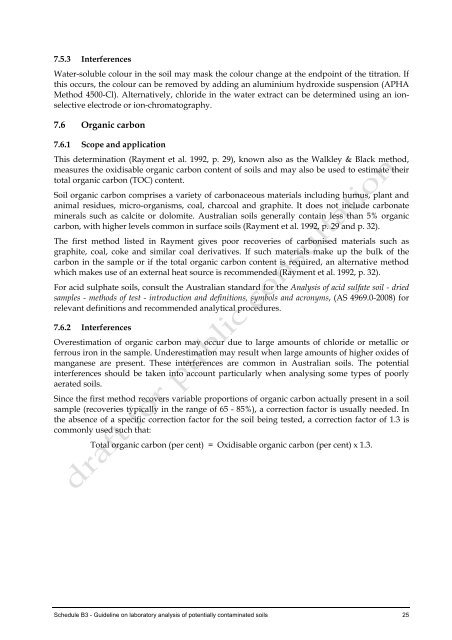Schedule B3 - COAG Standing Council on Environment and Water
Schedule B3 - COAG Standing Council on Environment and Water
Schedule B3 - COAG Standing Council on Environment and Water
- No tags were found...
You also want an ePaper? Increase the reach of your titles
YUMPU automatically turns print PDFs into web optimized ePapers that Google loves.
7.5.3 Interferences<br />
<strong>Water</strong>-soluble colour in the soil may mask the colour change at the endpoint of the titrati<strong>on</strong>. If<br />
this occurs, the colour can be removed by adding an aluminium hydroxide suspensi<strong>on</strong> (APHA<br />
Method 4500-Cl). Alternatively, chloride in the water extract can be determined using an i<strong>on</strong>selective<br />
electrode or i<strong>on</strong>-chromatography.<br />
7.6 Organic carb<strong>on</strong><br />
7.6.1 Scope <strong>and</strong> applicati<strong>on</strong><br />
This determinati<strong>on</strong> (Rayment et al. 1992, p. 29), known also as the Walkley & Black method,<br />
measures the oxidisable organic carb<strong>on</strong> c<strong>on</strong>tent of soils <strong>and</strong> may also be used to estimate their<br />
total organic carb<strong>on</strong> (TOC) c<strong>on</strong>tent.<br />
Soil organic carb<strong>on</strong> comprises a variety of carb<strong>on</strong>aceous materials including humus, plant <strong>and</strong><br />
animal residues, micro-organisms, coal, charcoal <strong>and</strong> graphite. It does not include carb<strong>on</strong>ate<br />
minerals such as calcite or dolomite. Australian soils generally c<strong>on</strong>tain less than 5% organic<br />
carb<strong>on</strong>, with higher levels comm<strong>on</strong> in surface soils (Rayment et al. 1992, p. 29 <strong>and</strong> p. 32).<br />
The first method listed in Rayment gives poor recoveries of carb<strong>on</strong>ised materials such as<br />
graphite, coal, coke <strong>and</strong> similar coal derivatives. If such materials make up the bulk of the<br />
carb<strong>on</strong> in the sample or if the total organic carb<strong>on</strong> c<strong>on</strong>tent is required, an alternative method<br />
which makes use of an external heat source is recommended (Rayment et al. 1992, p. 32).<br />
For acid sulphate soils, c<strong>on</strong>sult the Australian st<strong>and</strong>ard for the Analysis of acid sulfate soil - dried<br />
samples - methods of test - introducti<strong>on</strong> <strong>and</strong> definiti<strong>on</strong>s, symbols <strong>and</strong> acr<strong>on</strong>yms, (AS 4969.0-2008) for<br />
relevant definiti<strong>on</strong>s <strong>and</strong> recommended analytical procedures.<br />
7.6.2 Interferences<br />
Overestimati<strong>on</strong> of organic carb<strong>on</strong> may occur due to large amounts of chloride or metallic or<br />
ferrous ir<strong>on</strong> in the sample. Underestimati<strong>on</strong> may result when large amounts of higher oxides of<br />
manganese are present. These interferences are comm<strong>on</strong> in Australian soils. The potential<br />
interferences should be taken into account particularly when analysing some types of poorly<br />
aerated soils.<br />
Since the first method recovers variable proporti<strong>on</strong>s of organic carb<strong>on</strong> actually present in a soil<br />
sample (recoveries typically in the range of 65 - 85%), a correcti<strong>on</strong> factor is usually needed. In<br />
the absence of a specific correcti<strong>on</strong> factor for the soil being tested, a correcti<strong>on</strong> factor of 1.3 is<br />
comm<strong>on</strong>ly used such that:<br />
Total organic carb<strong>on</strong> (per cent) = Oxidisable organic carb<strong>on</strong> (per cent) x 1.3.<br />
<str<strong>on</strong>g>Schedule</str<strong>on</strong>g> <str<strong>on</strong>g>B3</str<strong>on</strong>g> - Guideline <strong>on</strong> laboratory analysis of potentially c<strong>on</strong>taminated soils 25
















